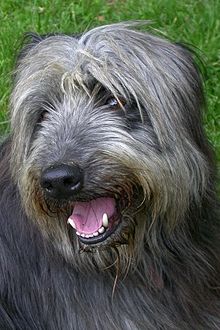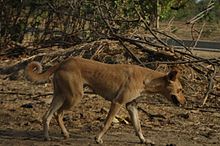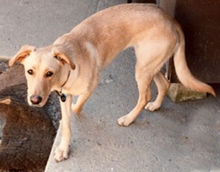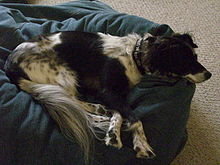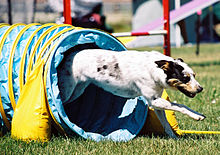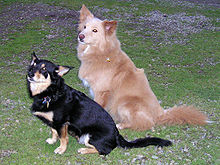
Mongrel
Background Information
SOS Children, an education charity, organised this selection. SOS Children is the world's largest charity giving orphaned and abandoned children the chance of family life.
A mongrel, mutt, or mixed-breed dog is a dog that belongs to no single organizationally recognized breed and is not the result of intentional breeding.
Mixed-breed vs. Crossbreed
While crossbred dogs, like many mongrels, are literally a mix of different breeds, they are the result of the intentional breeding programs and are therefore not considered "mixed breeds" or "mongrels" as these terms imply random, uncontrolled or unintended breeding.
When the term mixed-breed is used for mongrels with no purebred ancestors, it is technically a misnomer. The implication that such dogs must be a mix of defined breeds may stem from an inverted understanding of the origins of dog breeds. Pure breeds have been, for the most part, artificially created from random-bred populations by human selective breeding with the purpose of enhancing desired physical, behavioural, or temperamental characteristics. Dogs that are not purebred are not necessarily a mix of such defined breeds.
Regional and slang terms
There is a profusion of words and phrases used to describe dogs that are not designated as a purebred or pedigreed dog. The words cur, tyke, mutt, and mongrel are used, sometimes in a derogatory manner. There are also regional terms for mixed-breed dogs. In the United Kingdom mongrel is the unique technical word for a mixed-breed dog. North Americans generally prefer the term mix or mixed-breed. Mutt is also commonly used (in the U.S.A and Canada), often in an affectionate manner. Some American registries and dog clubs that accept mixed-breed dogs use the breed description All American.
There are also names for mixed-breeds based on geography, behaviour, or food. In Hawaii, mixes are referred to as poi dogs, although they are not related to the extinct Hawaiian poi dog. In The Bahamas and Turks and Caicos Islands, the common term is potcake dogs (referring to the table scraps they are fed). In South Africa the tongue-in-cheek expression pavement special is sometimes used as a description for a mixed-breed dog. In the Philippines, mixed-breed street dogs are often called " askals", a Tagalog-derived contraction of "asong kalye" or street dog. In Puerto Rico they are known as Sato dogs, and in Chile and Bolivia, they are called quiltros. In the rural southern United States, a small hunting dog is known as a feist.
Slang terms are also common. Heinz 57, Heinz, or Heinz Hound is often used for dogs of uncertain ancestry, in a playful reference to the "57 Varieties" slogan of the H. J. Heinz Company. In some countries, such as Australia, bitsa (or bitzer) is common, meaning "bits o' this, bits o' that". In Brazil and the Dominican Republic, the name for mixed-breed dogs is vira-lata (trash-can tipper) because of homeless dogs who knock over trash cans to reach discarded food. In Newfoundland, a smaller mixed-breed dog is known as a cracky, hence the colloquial expression "saucy as a cracky" for someone with a sharp tongue.
Appearance
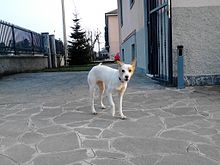
When breeds mix, their offspring manifest a wide variety of appearances; some resembling one breed closely, while others clearly exhibit features of both. However, as mixed breeds continue to interbreed, subsequent generations moderate toward a roughly similar appearance. They tend to be fawn or black and weigh about 18 kg (40 lb) and typically stand between 38 and 57 cm (15 and 23 inches) tall at the withers.
Determining ancestry
Guessing a mixed-breed's ancestry is difficult even for knowledgeable dog observers, because mixed-breeds have much more genetic variation than purebreds. For example, two black mixed-breed dogs might each have recessive genes that produce a blond coat and, therefore, produce offspring looking unlike their parents.
Starting in 2007, genetic analysis of blood samples and cheek swabs have become available to the public. The companies claim their DNA-based diagnostic test can genetically determine the breed composition of mixed-breed dogs. These tests are still limited in scope because only a small number of the hundreds of dog breeds have been validated against the tests, and because the same breed in different geographical areas may have different genetic profiles. Also, the tests do not test for breed purity, but for genetic sequences that are common to certain breeds. With a mixed-breed dog, the test is not proof of purebred ancestry, but rather an indication that those dogs share common ancestry with certain purebreds. The American Kennel Club does not recognize the use of DNA tests to determine breed.
As well, many newer dog breeds can be traced back to a common foundational breed, making them difficult to separate genetically. For example, Labrador Retrievers, Flat-coated Retrievers, Chesapeake Bay Retrievers, and Newfoundland Dogs share the ancestry of the St. John's water dog - a now extinct naturally-occurring dog breed from the island of Newfoundland.
Health
The theory of hybrid vigor suggests that as a group, dogs of varied ancestry will be healthier than their purebred counterparts. In purebred dogs, intentionally breeding dogs of very similar appearance over several generations produces animals that carry many of the same alleles, some of which are detrimental. If the founding population for the breed was small, then the genetic diversity of that particular breed may be small for quite some time. In essence, when humans select certain dogs for new breeds, they artificially isolate that group of genes and cause more copies of that gene to be made than might have otherwise occurred in nature. Initially, the population will be more fragile because of the lack of genetic diversity. If the dog breed is popular, and the line continues, over hundreds of years, there will be more diversity due to mutations and occasional out-breeding; like an island with a few new birds—they will diversify. This is why some of the very "old" breeds are more stable. The problem is when certain traits found in the breed standard are associated with genetic disorders. Then, the artificial selective force favors the duplication of the genetic order, because it comes with a different, desired, physical trait.
Populations are particularly vulnerable when the dogs bred are closely related. Inbreeding among purebreds has exposed various genetic health problems not always readily apparent in less uniform populations. Mixed-breed dogs are more genetically diverse due to the more haphazard nature of their parents' mating. "Haphazard" is not the same as "random" to a geneticist. The offspring of such matings might be less likely to express certain genetic disorders because there might be a decreased chance that both parents carry the same detrimental recessive alleles. However, some deleterious recessives occur across many seemingly unrelated breeds, and therefore merely mixing breeds is no guarantee of genetic health.
"Hybrids have a far lower chance of exhibiting the disorders that are common with the parental breeds", but crossbreeding two poor specimens together does not guarantee the resulting offspring will be healthier than the parents because the offspring could inherit the worst traits of both parents. This is commonly seen in dogs from puppy mills. Healthy traits have been lost in many purebred dogs lines because many breeders of showdogs are more interested in conformation - the physical attributes of the dogs in relation to the breed standard - than in the health and working temperament for which the dog was originally bred.
Purebred and mixed-breed dogs are equally susceptible to most non-genetic ailments, such as rabies, distemper, injury, and infestation by parasites.
Several studies have shown that mixed-breed dogs have a health advantage. A German study finds that "Mongrels require less veterinary treatment". Studies in Sweden have found that "Mongrel dogs are less prone to many diseases than the average purebred dog" and, referring to death rates, “Mongrels were consistently in the low risk category”. Data from Denmark also suggest that mixed breeds have higher longevity on average compared to purebreeds. A British study showed similar results but a few breeds (notably Jack Russell Terrier, Miniature Poodles and Whippets) lived longer than mixed breeds.
In one landmark study,the effect of breed on longevity in the pet dog was analyzed using mortality data from 23,535 pet dogs. The data was obtained from North American veterinary teaching hospitals. The median age at death was determined for pure and mixed breed dogs of different body weights. Within each body weight category, the median age at death was lower for pure breed dogs compared with mixed breed dogs. The median age at death was "8.5 years for all mixed breed dogs, and 6.7 years for all pure breed dogs" in the study.
Types of mongrels
Mongrels dogs can be divided roughly into four types:
- Mixes that show characteristics of two or more breeds. A mix might have some purebred ancestors, or might come from a long line of mixed-breeds. These dogs are usually identified by the breed they most resemble, such as a "Lab mix" or "Collie-Shepherd", even if their ancestry is unknown.
- The generic pariah dog, or feral Canis lupus familiaris, where non-selective breeding has occurred over many generations. The term originally referred to the wild dogs of India, but now refers to dogs belonging to or descended from a population of wild or feral dogs. The Canaan Dog is an example of a recognized breed with pariah ancestry. Pariah dogs tend to be yellow to light brown and of medium height and weight. This may represent the appearance of the modern dog's ancestor. DNA analysis has shown pariah dogs to have a more ancient gene pool than modern breeds.
- Functional breeds, which are purpose-bred dogs whose ancestors are not purebred, but rather are selected by their performance at a particular tasks. Examples of this are the Alaskan Husky, the Eurohound, and the Pointer/Greyhound mixes referred to as Greysters, which compete at skijoring and pulka races, particularly in Europe. The distinction between a "mix" and a "breed" is less distinct in these cases, and occasionally a functional breed such as this becomes accepted as a breed over time.
- Crossbreed dogs, which are mixtures of two recognized breeds. Dogs that result from two different purebred parents are known as crossbreeds. Some crossbreeds have become popular enough to be frequently bred deliberately, such as the Cockapoo—a cross between a Poodle and a Cocker Spaniel. Other crosses are bred in an attempt to add or reinforce desired characteristics.
Purebred dogs are known by breed names given to groups of dogs that are visibly similar in most characteristics and have reliable documented descent. But in recent years many owners and breeders of crossbreed dogs identify them — often facetiously — by invented names constructed from parts of the parents' breed names. These are known as portmanteau names and the resulting crosses as "designer dogs." For example, a cross between a Pekingese and a Poodle may be referred to as a Peekapoo. Another trendy cross is the Goldendoodle, a cross between a standard poodle and a golden retriever.
Mixed-breeds in dog sports
Mixed-breed dogs can excel at dog sports, such as obedience, dog agility, flyball, and frisbee. Often, highly energetic mixed-breeds are left with shelters or rescue groups, where they are sought by owners with the caring, patience, and drive to train them for dog sports, turning unwanted dogs into healthy, mentally and physically stimulated award winners.
Until the early 1980s, mixed-breed dogs were usually excluded from obedience competitions. However, starting with the American Mixed Breed Obedience Registry (AMBOR) and the Mixed Breed Dog Clubs of America (MBDCA), which created obedience venues in which mixed-breed dogs could compete, more opportunities have opened up for all dogs in all dog sports. Most dog agility and flyball organizations have always allowed mixed-breed dogs to compete. Today, mixed-breeds have proved their worth in many performance sports.
In conformation shows, where dogs' conformation to a breed standard is evaluated, mixed-breed dogs normally cannot compete. For purebred dogs, their physical characteristics are judged against a single breed standard. Mixed-breed dogs, however, are difficult to classify except according to height; there is tremendous variation in physical traits such as coat, skeletal structure, gait, ear set, eye shape and colour, and so on. When conformation standards are applied to mixed-breed dogs, such as in events run by the MBDCA, the standards are usually general traits of health, soundness, symmetry, and personality. The Kennel Club (UK) operates a show called Scruffts (a name derived from its prestigious Crufts show) open only to mixed-breeds in which dogs are judged on character, health, and temperament. Some kennel clubs, whose purpose is to promote purebred dogs, still exclude mixed-breeds from their performance events. The AKC and the FCI are two such prominent organizations. While the AKC does allow mixed-breed dogs to earn their Canine Good Citizen award, mixed-breed dogs are not permitted to enter AKC "all breed" events, though through their "Canine Partners" program, mixed breed dogs can be registered to compete in AKC Agility, Obedience, and Rally events.
Advantages and drawbacks
The mature appearance and behaviour of purebred puppies may be more predictable than that of mixed-breeds. With purebred dogs, genetic variations occur within a narrow gene pool, and a reputable breeder has a fair estimation of what type of offspring a given pair will produce. Still, there is considerable variation of appearance and personality within breeds. For example, two champion sheep-herding Border Collies might produce offspring with no interest in sheep herding.
Some trainers believe mixed-breeds exhibit higher average intelligence than purebreds, but others believe mixes are generally no more intelligent than purebreds. Both sets feature slow learners and dogs with high learning capacity alike.
Studies that have been done in the area of health show that mixed-breeds on average are both healthier and longer-lived than their purebred relations. This is because current accepted breeding practices within the pedigreed community results in a reduction in genetic diversity, and can result in physical characteristics that lead to health issues.
Studies have shown that cross-bred dogs have a number of desirable reproductive traits. Scott and Fuller found that cross-bred dogs were superior mothers compared to purebred mothers, producing more milk and giving better care. These advantages led to a decreased mortality in the offspring of cross-bred dogs.
Not all dog owners appreciate mixed-breed dogs. Some owners value a dog's pedigree as a status symbol and, therefore, have no use for mixed-breed dogs; others appreciate or have an emotional attachment to the physical or behavioural traits of certain breeds; still others erroneously believe that a pedigree means a dog will have superior personality traits and health.
While purebred dogs exhibit a narrow range of appearance within their breed, mixed-breed dogs often exhibit unique appearances. People who enjoy mixed-breeds often value their one-of-a-kind appearance and characteristics. Local animal shelters adopt out dogs of both purebred and mixed ancestry, emphasizing each dog's personality and suitability as a companion for each potential owner's lifestyle.
